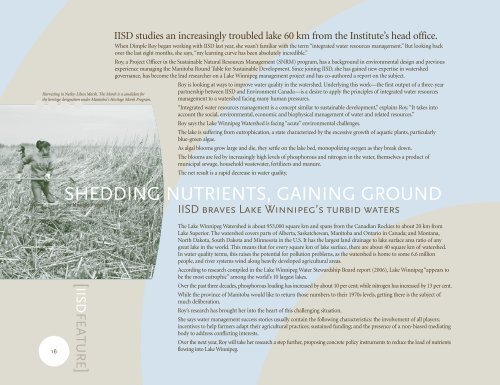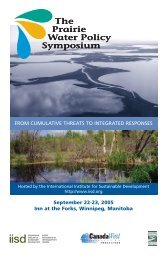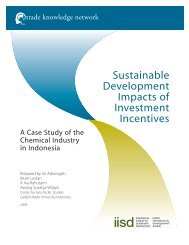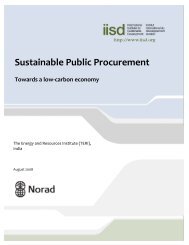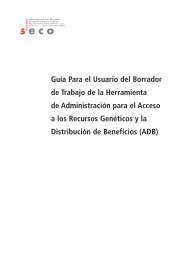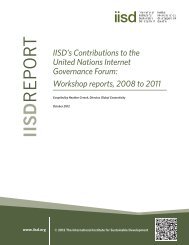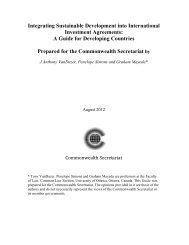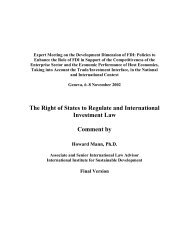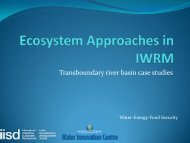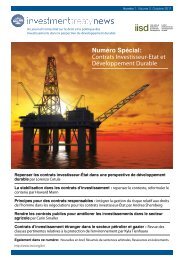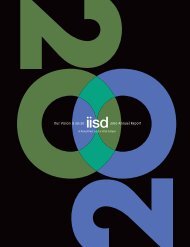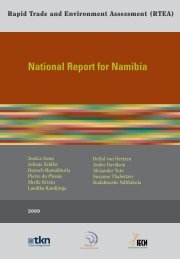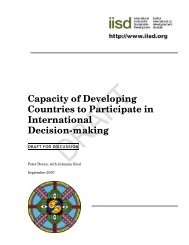2006/2007 Annual Report - International Institute for Sustainable ...
2006/2007 Annual Report - International Institute for Sustainable ...
2006/2007 Annual Report - International Institute for Sustainable ...
Create successful ePaper yourself
Turn your PDF publications into a flip-book with our unique Google optimized e-Paper software.
Harvesting in Netley-Libau Marsh. The Marsh is a candidate <strong>for</strong><br />
the heritage designation under Manitoba's Heritage Marsh Program.<br />
IISD studies an increasingly troubled lake 60 km from the <strong>Institute</strong>’s head office.<br />
When Dimple Roy began working with IISD last year, she wasn’t familiar with the term “integrated water resources management.” But looking back<br />
over the last eight months, she says, “my learning curve has been absolutely incredible.”<br />
Roy, a Project Officer in the <strong>Sustainable</strong> Natural Resources Management (SNRM) program, has a background in environmental design and previous<br />
experience managing the Manitoba Round Table <strong>for</strong> <strong>Sustainable</strong> Development. Since joining IISD, she has gained new expertise in watershed<br />
governance, has become the lead researcher on a Lake Winnipeg management project and has co-authored a report on the subject.<br />
Roy is looking at ways to improve water quality in the watershed. Underlying this work—the first output of a three-year<br />
partnership between IISD and Environment Canada—is a desire to apply the principles of integrated water resources<br />
management to a watershed facing many human pressures.<br />
“Integrated water resources management is a concept similar to sustainable development,” explains Roy. “It takes into<br />
account the social, environmental, economic and biophysical management of water and related resources.”<br />
Roy says the Lake Winnipeg Watershed is facing “acute” environmental challenges.<br />
The lake is suffering from eutrophication, a state characterized by the excessive growth of aquatic plants, particularly<br />
blue-green algae.<br />
As algal blooms grow large and die, they settle on the lake bed, monopolizing oxygen as they break down.<br />
The blooms are fed by increasingly high levels of phosphorous and nitrogen in the water, themselves a product of<br />
municipal sewage, household wastewater, fertilizers and manure.<br />
The net result is a rapid decrease in water quality.<br />
SHEDDING NUTRIENTS, GAINING GROUND<br />
By Michelle French<br />
IISD braves Lake Winnipeg’s turbid waters<br />
16<br />
[IISDFEATURE]<br />
The Lake Winnipeg Watershed is about 953,000 square km and spans from the Canadian Rockies to about 20 km from<br />
Lake Superior. The watershed covers parts of Alberta, Saskatchewan, Manitoba and Ontario in Canada; and Montana,<br />
North Dakota, South Dakota and Minnesota in the U.S. It has the largest land drainage to lake surface area ratio of any<br />
great lake in the world. This means that <strong>for</strong> every square km of lake surface, there are about 40 square km of watershed.<br />
In water quality terms, this raises the potential <strong>for</strong> pollution problems, as the watershed is home to some 6.6 million<br />
people, and river systems wind along heavily developed agricultural areas.<br />
According to research compiled in the Lake Winnipeg Water Stewardship Board report (<strong>2006</strong>), Lake Winnipeg “appears to<br />
be the most eutrophic” among the world’s 10 largest lakes.<br />
Over the past three decades, phosphorous loading has increased by about 10 per cent; while nitrogen has increased by 13 per cent.<br />
While the province of Manitoba would like to return those numbers to their 1970s levels, getting there is the subject of<br />
much deliberation.<br />
Roy’s research has brought her into the heart of this challenging situation.<br />
She says water management success stories usually contain the following characteristics: the involvement of all players;<br />
incentives to help farmers adapt their agricultural practices; sustained funding; and the presence of a non-biased mediating<br />
body to address conflicting interests.<br />
Over the next year, Roy will take her research a step further, proposing concrete policy instruments to reduce the load of nutrients<br />
flowing into Lake Winnipeg.


